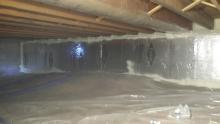- Energy Testing
- Insulation
- Windows
- Radon Mitigation
- Energy Solutions
- Attic Air Sealing
- Attic Insulation
- Attic Ventilation
- Rim Joists: Insulation and Air Sealing
- Rooms above garages
- Sidewalls (Open & Closed Cavities)
- Sloped & Vaulted Ceilings
- Bathroom Exhaust Fans
- Basement Walls
- Story-and-a-half Homes: Cape Cod, Salt Box, Modified A-Frame, Bungalow
- Crawlspace Moisture Control & Insulation
- Insulation Cantilevered floors
- Ice Dams
- Rebates & Incentives
Leaky rim joists and un-insulated foundation walls in crawlspaces are often the major infiltration point for outside air. During the cold winters in the Twin Cities Metro area, these areas leak out hot air, cooling the basement and taxing heating equipment, especially when ductwork and plumbing runs through the space. Cool, air-conditioned air leaks out during the summer, slowly turning your cool home into a lukewarm, uncomfortable space.
Making sure these areas are properly insulated and sealed is key to maintaining comfort in the home and keeping your utility bills down.
“Conditioning” Your Crawlspace

Properly insulating a crawlspace usually means bringing it into the “conditioned space” of the home, so the environment in the crawlspace matches the environment in, say, the bedroom. Rather than isolating the room above from the crawlspace, the space is sealed and insulated against the outdoor (“ambient”) air.
Controlling Outdoor Moisture
Unfinished crawlspace floors should have a vapor barrier in place. The walls and rims should also be insulated with closed cell polyurethane foam. These measures ensure that only minimal amounts of heat are lost to the outside, and that no moisture migrates in from the surrounding soil.
In some taller crawlspaces, foam board may be applied to exterior walls as well. Moisture wicking insulation materials (like fiberglass) should not be used in these spaces. If SCES is doing a renovation, we’ll often discard any leftover fiberglass insulation, since it retains moisture and odors.
Don’t let nasty crawlspaces make your home uncomfortable. Get in touch with us to set up a crawlspace evaluation.
Contact UsEnergy Assessments for $450 or less
Schedule your FREE Home Estimate
Testimonials
Kay P., Hudson, WI
Aaron, Pete, Jim & Jim Thank you for putting up with the questions, phone calls & emails I had during this process. I am looking forward to hot summer temperatures and a warm house this winter. What a Blessing that will be!
